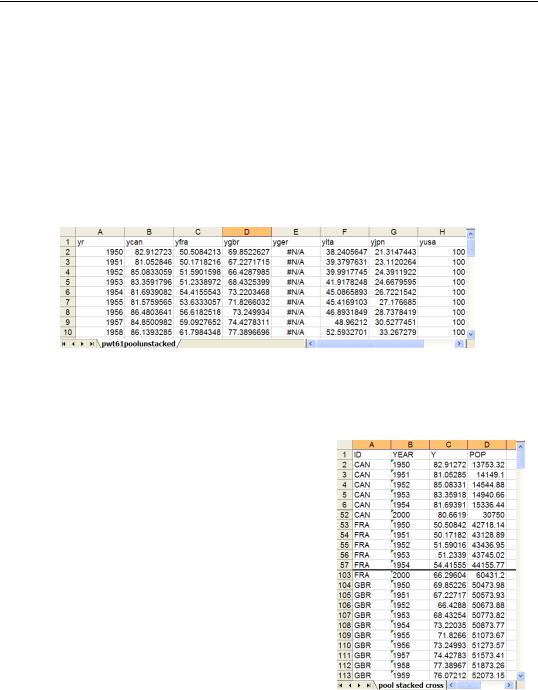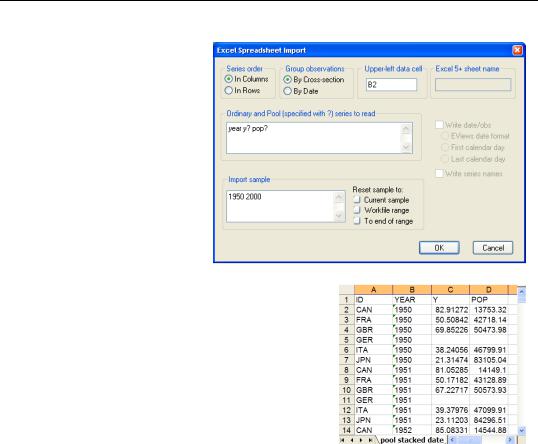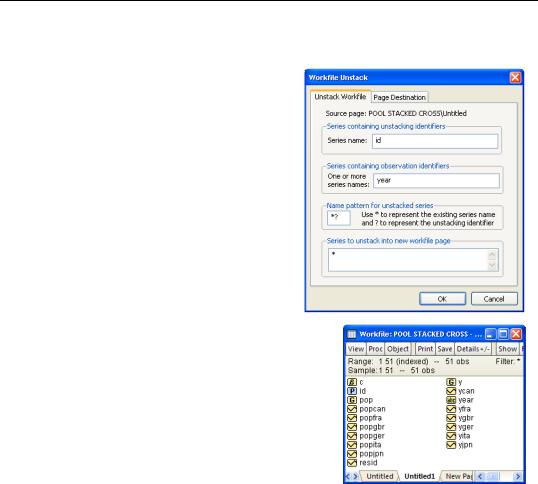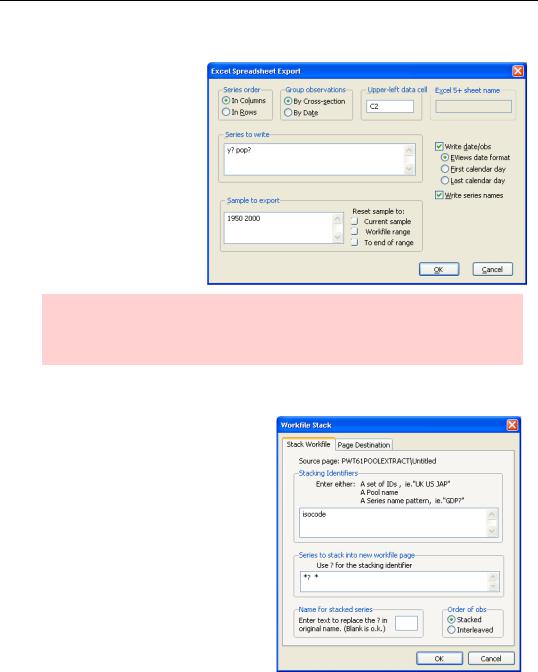
- •Table of Contents
- •Foreword
- •Chapter 1. A Quick Walk Through
- •Workfile: The Basic EViews Document
- •Viewing an individual series
- •Looking at different samples
- •Generating a new series
- •Looking at a pair of series together
- •Estimating your first regression in EViews
- •Saving your work
- •Forecasting
- •What’s Ahead
- •Chapter 2. EViews—Meet Data
- •The Structure of Data and the Structure of a Workfile
- •Creating a New Workfile
- •Deconstructing the Workfile
- •Time to Type
- •Identity Noncrisis
- •Dated Series
- •The Import Business
- •Adding Data To An Existing Workfile—Or, Being Rectangular Doesn’t Mean Being Inflexible
- •Among the Missing
- •Quick Review
- •Appendix: Having A Good Time With Your Date
- •Chapter 3. Getting the Most from Least Squares
- •A First Regression
- •The Really Important Regression Results
- •The Pretty Important (But Not So Important As the Last Section’s) Regression Results
- •A Multiple Regression Is Simple Too
- •Hypothesis Testing
- •Representing
- •What’s Left After You’ve Gotten the Most Out of Least Squares
- •Quick Review
- •Chapter 4. Data—The Transformational Experience
- •Your Basic Elementary Algebra
- •Simple Sample Says
- •Data Types Plain and Fancy
- •Numbers and Letters
- •Can We Have A Date?
- •What Are Your Values?
- •Relative Exotica
- •Quick Review
- •Chapter 5. Picture This!
- •A Simple Soup-To-Nuts Graphing Example
- •A Graphic Description of the Creative Process
- •Picture One Series
- •Group Graphics
- •Let’s Look At This From Another Angle
- •To Summarize
- •Categorical Graphs
- •Togetherness of the Second Sort
- •Quick Review and Look Ahead
- •Chapter 6. Intimacy With Graphic Objects
- •To Freeze Or Not To Freeze Redux
- •A Touch of Text
- •Shady Areas and No-Worry Lines
- •Templates for Success
- •Point Me The Way
- •Your Data Another Sorta Way
- •Give A Graph A Fair Break
- •Options, Options, Options
- •Quick Review?
- •Chapter 7. Look At Your Data
- •Sorting Things Out
- •Describing Series—Just The Facts Please
- •Describing Series—Picturing the Distribution
- •Tests On Series
- •Describing Groups—Just the Facts—Putting It Together
- •Chapter 8. Forecasting
- •Just Push the Forecast Button
- •Theory of Forecasting
- •Dynamic Versus Static Forecasting
- •Sample Forecast Samples
- •Facing the Unknown
- •Forecast Evaluation
- •Forecasting Beneath the Surface
- •Quick Review—Forecasting
- •Chapter 9. Page After Page After Page
- •Pages Are Easy To Reach
- •Creating New Pages
- •Renaming, Deleting, and Saving Pages
- •Multi-Page Workfiles—The Most Basic Motivation
- •Multiple Frequencies—Multiple Pages
- •Links—The Live Connection
- •Unlinking
- •Have A Match?
- •Matching When The Identifiers Are Really Different
- •Contracted Data
- •Expanded Data
- •Having Contractions
- •Two Hints and A GotchYa
- •Quick Review
- •Chapter 10. Prelude to Panel and Pool
- •Pooled or Paneled Population
- •Nuances
- •So What Are the Benefits of Using Pools and Panels?
- •Quick (P)review
- •Chapter 11. Panel—What’s My Line?
- •What’s So Nifty About Panel Data?
- •Setting Up Panel Data
- •Panel Estimation
- •Pretty Panel Pictures
- •More Panel Estimation Techniques
- •One Dimensional Two-Dimensional Panels
- •Fixed Effects With and Without the Social Contrivance of Panel Structure
- •Quick Review—Panel
- •Chapter 12. Everyone Into the Pool
- •Getting Your Feet Wet
- •Playing in the Pool—Data
- •Getting Out of the Pool
- •More Pool Estimation
- •Getting Data In and Out of the Pool
- •Quick Review—Pools
- •Chapter 13. Serial Correlation—Friend or Foe?
- •Visual Checks
- •Testing for Serial Correlation
- •More General Patterns of Serial Correlation
- •Correcting for Serial Correlation
- •Forecasting
- •ARMA and ARIMA Models
- •Quick Review
- •Chapter 14. A Taste of Advanced Estimation
- •Weighted Least Squares
- •Heteroskedasticity
- •Nonlinear Least Squares
- •Generalized Method of Moments
- •Limited Dependent Variables
- •ARCH, etc.
- •Maximum Likelihood—Rolling Your Own
- •System Estimation
- •Vector Autoregressions—VAR
- •Quick Review?
- •Chapter 15. Super Models
- •Your First Homework—Bam, Taken Up A Notch!
- •Looking At Model Solutions
- •More Model Information
- •Your Second Homework
- •Simulating VARs
- •Rich Super Models
- •Quick Review
- •Chapter 16. Get With the Program
- •I Want To Do It Over and Over Again
- •You Want To Have An Argument
- •Program Variables
- •Loopy
- •Other Program Controls
- •A Rolling Example
- •Quick Review
- •Appendix: Sample Programs
- •Chapter 17. Odds and Ends
- •How Much Data Can EViews Handle?
- •How Long Does It Take To Compute An Estimate?
- •Freeze!
- •A Comment On Tables
- •Saving Tables and Almost Tables
- •Saving Graphs and Almost Graphs
- •Unsubtle Redirection
- •Objects and Commands
- •Workfile Backups
- •Updates—A Small Thing
- •Updates—A Big Thing
- •Ready To Take A Break?
- •Help!
- •Odd Ending
- •Chapter 18. Optional Ending
- •Required Options
- •Option-al Recommendations
- •More Detailed Options
- •Window Behavior
- •Font Options
- •Frequency Conversion
- •Alpha Truncation
- •Spreadsheet Defaults
- •Workfile Storage Defaults
- •Estimation Defaults
- •File Locations
- •Graphics Defaults
- •Quick Review
- •Index
- •Symbols

Getting Data In and Out of the Pool—309
Getting Data In and Out of the Pool
Since pooled series are just ordinary series, you’re free to load them into EViews any way that you find convenient. But there are two data arrangements that are common: unstacked and stacked. These data arrangements correspond to the spreadsheet arrangements we saw in Spreadsheet Views earlier in the chapter. Unstacked data are read through a standard File/Open. (See Chapter 2, “EViews—Meet Data.”) EViews provides some special help for stacked data.
Importing Unstacked Data
Here’s an excerpt of an Excel spreadsheet with unstacked data.
Since we have ordinary series with conveniently chosen names, load in the spreadsheet in the usual way, create a pool object with suffixes CAN, FRA, etc., and bob’s your uncle.
Importing Stacked Data—The Direct Method
Here’s an excerpt of an Excel spreadsheet with stacked data—stacked by cross-section. We’ve hidden some of the rows so you can see the whole pattern. All the data for the first country appears first, stacked on top of the data for the second country, etc. While Y and POP appear in the first row, the country specific series names, such as YCAN, don’t appear.

310—Chapter 12. Everyone Into the Pool
We want EViews to help out by attaching the identifiers in the first column to the series names beginning with Y and POP. With the pool window active, choose the menu
Proc/Import Pool data (ASCII,XLS,WK?)…. Fill out the dialog with the names of the series to import, as in the example to the right. Hit
 and EViews will get everything properly attached.
and EViews will get everything properly attached.
Not surprisingly, stacked by date is the flipped-on- the-side version of stacked by cross-section. Here’s an excerpt. The same Proc/Import Pool data (ASCII,XLS,WK?)… command works fine—just choose the By Date radio button instead of By Cross-section.

Getting Data In and Out of the Pool—311
Importing Stacked Data—The Indirect Method
Sometimes, a little indirection makes life go more smoothly. In the case at hand, it’s often easier to simply read your data into EViews by the methods you’re already familiar with (for example, we might read in our data by drag- and-dropping the file onto the EViews desktop and clicking on  to accept the defaults) and then work with it in panel form (see Chapter 11, “Panel—What’s My Line?”), or transform it into pooled form using
to accept the defaults) and then work with it in panel form (see Chapter 11, “Panel—What’s My Line?”), or transform it into pooled form using
Proc/Reshape Current Page/Unstack in New Page…. and filling out the Workfile Unstack dialog as shown.
Click  and you have a new page set
and you have a new page set
up in pooled form. In fact, to help out EViews has even set up a pool object for you.

312—Chapter 12. Everyone Into the Pool
Exporting Stacked Data
Typically, unstacked data are easier to operate on, but sometimes stacked data are easier for humans to read. The inverse of Proc/Import
Pool data (ASCII,XLS,WK?)… is
Proc/Export Pool data (ASCII,XLS,WK?)…. Choose By Date or By Cross-section and away you go.
Hint: EViews includes the “?” in the series name in the output file. You might choose to manually delete the “?” in the exported file to improve the appearance of the output.
Exporting Stacked Data—A Little Indirection Here Too
Not surprisingly, there’s an indirect method for exporting, too. To stack data in a new page in preparation for using any of the usual export tools, choose
Proc/Reshape Current Page/Stack in New Page…. In the Workfile Stack dialog, enter the name of the pool object. Click  for a nicely stacked page.
for a nicely stacked page.
Quick Review—Pools
The pool feature lets you analyze multiple series observed for the same variable, such as GDP series for a number of countries. You can pool the data in a regression with common

Quick Review—Pools—313
coefficients for all countries. You can also allow for individual coefficients by cross-section or by period for any variable. Fixed and random effect estimators are built-in. And because pooled series are just plain old series with a clever naming convention, all of the EViews features are directly available. See Chapter 11, “Panel—What’s My Line?” for a different approach to two dimensional data.

314—Chapter 12. Everyone Into the Pool
